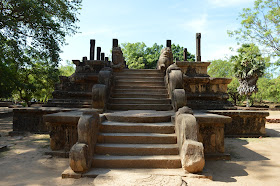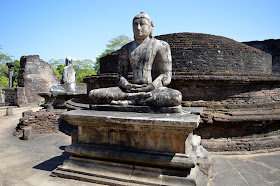 |
| The reclining Buddha at Gal Vihara |
The B&B manager recommended a full day in Polonnaruwa and it is easily access via a public bus but we really wanted to do both sights (Read: greedy, lol) so we decided to arrange for a tuk-tuk to get us to Polonnaruwa and back so we save on time. Besides we would need a transport (hired bicycle) to get from site to site in Polonnaruwa, so instead of bicycle, we have the tuk-tuk to get us around. The plan was Polonnaruwa in the morning half, and safari in Minneriya National Park in the afternoon at 2 pm.
Tuk-tuk from B&B to Polonnaruwa and around, then back to B&B cost us LKR 4,500 / ~AUD 40 / ~USD 30. Polonnaruwa entrance fee was LKR 3,150 pp /~AUD 28 / ~USD 22).
 |
| Took this photo when the driver stopped by a temple to pay his respect. Later I noticed the bus conductor of the bus in photo also did the same |
On hindsight it is probably a wise decision to have a tuk-tuk ferrying us from site to site as it was scorching hot. I am not sure if I would be motivated to see many of the sights if we were cycling or worse, walking. Our tuk-tuk driver was quite clue-y despite some language barrier but he understood what we tried to ask him and he would tell us which site to go to first, etc.
We saw an elephant on our way to Polonnaruwa as Minneriya National Park is along the way from Habarana. Our tuk-tuk driver stopped by the road side for us to see the elephant. ^^
We got our tickets and the lady at the counter gave us a little map on the location of the sight. Our game plan was to select the ones to visit and drop the rest if we are running late. I happily outsourced the task of selecting the site to my friend as she holds the guide book... hehe. I did, however, skim through this informative blog post of the same.
We started off with the Dipauyana (Island Park), which is nearest to the ticket selling point.
From this area to the other parts of Polonnaruwa, our tuk-tuk driver brought us passed this lake, from memory it is man-made.
 |
| Beautiful blue sky = hot |
It is said that the statue was fro the Polonnaruwa period, and the statue is King Parakramabahu the Great (1153-1186). What I thought was interesting was the sign above where I think it is trying to say not to pose with the statue? Maybe.
Next up was Nissankamalla Palace Complex. This is an Audience Hall, and said to probably held a wooden roof. Of course, now only the stone pillars are left.
 |
| Two lions flanking the entrance to the hall |
 |
| Elephants carving at the side of the structure |
After that, we walked to the Parakramabahu Palace Complex or Royal Palace. I have no idea how the structure shows it was a 7 storied palace but the information at site stated so. It even went on to say that the remains of three stories can still be identified. The full given name of this palace was Palace of God Sakra.
I was getting really uncomfortable with the heat by this time and though the said three storied structure provided good shade from the sun. I'm sorry King Parakramabahu.
There was more to come, so we made our way to the Sacred Quadrangle (Dalada Maluva).
As the name hinted, there are a collection of structures inside this quadrangle.
First up was the Vatadage (Circular Relic House). Vatadage means stupa and the arrangement of this Vatadage is symmetrical with seated Buddhas at each of the four cardinal directions.
 |
| Moonstone when enter the Vatadage |
As these are all essentially temples, one would need to remove your shoes to enter the monuments. I had on a pair of white socks that day but this time round I decided to leave my socks on which proved to be a smarter decision on my part. The instructions said to remove shoes, nothing was mention about socks so I take that it is acceptable. Having the socks on really did make walking on the hot sand ground much bearable.
Initially I was hesitant on entering the building due to my lack of motivation to remove my shoes or just general lack of motivation due to the heat. I was glad I did though and for some unknown reason, after entering the Vatadage, I actually felt zen under the scorching hot sun. The heat no longer bothered me as it did before. Maybe I have levelled up to Po's zen-ness, only in terms of walking in the heat. So I enter the opposite building - Hatadage as well. Haha. "Hata" means sixty, rumour said that it was built in sixty hours, hence the name. Maybe not.
 |
| I even took time to shoot this bright coloured insect. I don't know what it is though |
As you can see, out of the three standing Buddha on display in Hatadage, the one at the leftmost is the one better preserved. It is said that the three standing Buddha could be intended to represent the Buddhas of the past, present and future.
Next to the Hatadage is the Atadage. It is said that "Ata" means eight and it could be named so as it used to house eight relics in the past. It is also said to be the first tooth relic temple. Of course, currently the Temple of the Tooth is found in Kandy.
In the same quadrangle also house a pyramid shaped, seven storied temple - Sathmahal Prasadaya. It is said that similar stupa to Sathmahal Prasadaya can be seen in Cambodia. The last storey had crumbled, it is now left with six.
Leaving the Sacrad Quadrangle, the next one we headed to is the oldest Hindu shrine in Polonnaruwa - Siva Devala No 2. It dated back to the early years of the Chola occupation.
Then we have a slightly different structure buildings. This is Rankot Vehera.
Rankot Vehera is the largest stupa in Polonnaruwa, standing at 55m tall. It was said to try to imitate the great stupas at Anuradhapura.
By this time I was quite templed-out and easily distracted with the coconut water stalls across from this stupa. So naturally we got ourselves a refreshing coconut each as a reward, as well as one for our tuk-tuk driver. Confession - I am quite bad at recognising people and there were a few tuk-tuk drivers sitting under the tree waiting, halfway walking towards him with a coconut, I suddenly thought, "Did I got the right driver?" haha. So i double back to confirm with my friend. Oops.
Our tuk-tuk driver told us we would need to see the next one as we were telling him of skipping some out. :P This is also a stupa but white in colour. Dagaba Kiri Vihara or translated as "milk white shrine" is believed to be dedicated to Subhadra, the queen of King Parakramabahu (1153-1186). It was believed that when this dagoba was found, it was in a perfect condition of original lime plaster. It is the best-preserved unrestored dagoba at Polonnaruwa.
 |
| I am pretty sure this is re-painted... maybe many times |
And yes, to get here, you would need to leave your shoes at the entrance.
After this, we made only one stop before leaving Polonnaruwa - which was to see the Nelum Pokuna (Lotus Bath).
Lotus Bath was bult by King Parakramabahu in the design of 8 petal lotus flower, believed to have been used for ritual bath for pilgrims visiting Tivanka-patanaghara image house which we decided to skip.
We decided to head back to Habarana and have a lunch plus rest before heading out to see the elephants. On our way back, our tuk-tuk driver bought us an ear of corn each, maybe because of the earlier coconut water. It helped to tie us over to lunch. :)
Side note: I've just had 2 slices of french toast and I'm hungry again. = ="
























No comments:
Post a Comment